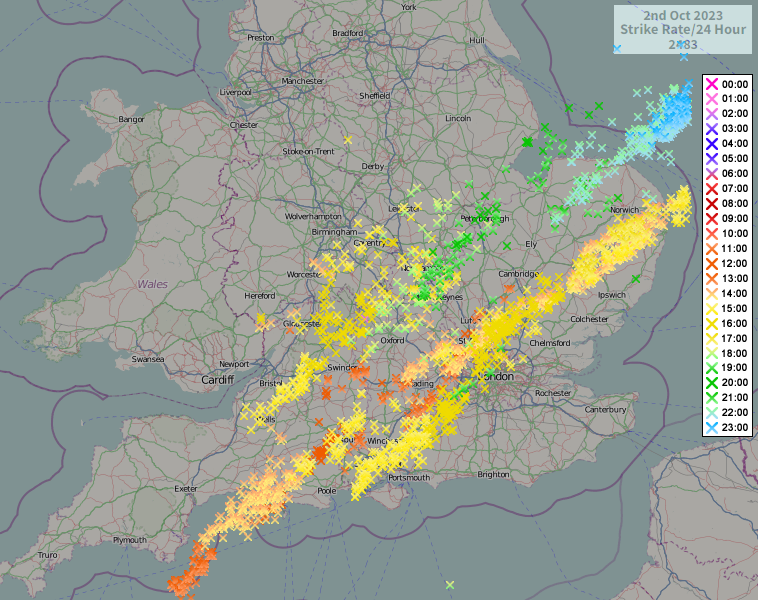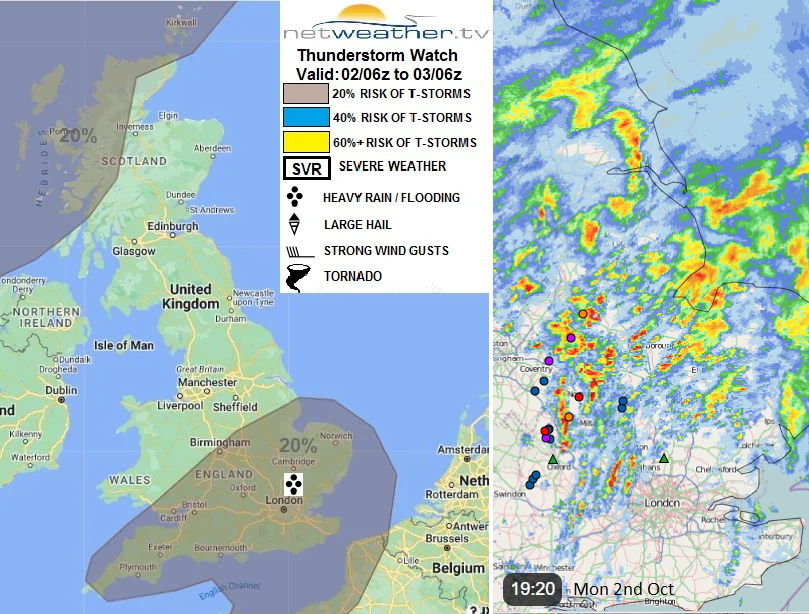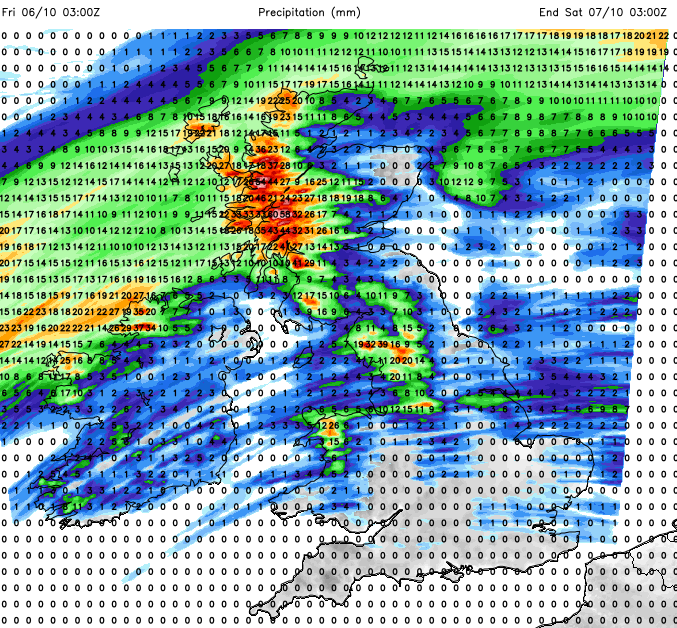
As we await the weekend warmth, there have been thunderstorms making the weather headlines and later this week there will be persistent rain for western Scotland which will go on for days and is likely to cause disruptive flooding.

Thunderstorms brought downpours and lightning strikes yesterday from Dorset across to East Anglia, around north and west London until the evening when everything edged east/northeast. Two people were struck by lightning in Hertfordshire and there were spectacular scenes later in the day over the skies of Oxfordshire. Downpours and thunderstorms continued into the evening as a lightning strike managed to hit a tank at biomass plant. It seemingly exploded and impacted other tanks too with bright yellow light appearing in the darkening evening sky.
The Met Office in the UK issues weather warnings for frontal rain, snow, high winds etc but the warning of storms and lightning doesn’t seem to fit. It is highly unlikely in the UK that a lightning strike will hit one particular place but the impacts are high. A wide warning area will leave many wondering “where are the storms” whereas it is about risk within a zone.

For people planning hill walks or outdoor sports, checking the radar and sferics before and during events, when the potential for storms is present, is really important. If thunderstorms are forecast, organizers should consider adapting, cancelling or postponing the activity
When thunder roars, head indoors
Basic starting points are: if you see lightning, even in the distance, if you hear thunder or the skies look threatening. It may be hard for those involved in matches and practice to monitor the weather as well as the activities so everyone keeping an eye out and sharing should be encouraged.
Then delay the start or take a break and seek suitable shelter. That will depend on where you are but this could be just inside cars with the windows up. Sheds or dugouts are not suitable. Indoor buildings are good but stay away from wiring and plumbing.
Threatening skies can be tricky if you are not sure what you are looking for. A classic CB cloud, a cumulonimbus with an anvil top is rather distinctive but often other clouds block the view. Also sometimes in the evening, clouds can look more ominous and dark due to a lack of sunlight getting through them, rather than being threatening.
“Based on cases documented by the National Weather Service in recent years, about 30 people are killed by lightning each year and hundreds more are injured, some suffering devastating neurological injuries that persist for the rest of their lives. About two thirds of the deaths are associated with outdoor recreational activities.” NWS in USA
In the UK, it is more like 2 people per year, with around 30 to 50 people being struck by lightning.
Checking on the radar with the lightning detection turned on can help a lot. Keeping an eye out for the Netweather Convective forecast maps, which highlight the potential risk across Great Britain and Ireland.
It is not foolproof though. Not all the lightning strikes will show up and there is a 1-2km range when plotting. It is good for showing the development and movement of thundery plumes, clusters of storms and cells popping up. Any intense rainfall will show up and a selection of sferics, the lightning strikes will add to the overall picture.

If the storm looks to have passed, then check on the radar again for what is coming next. Make sure lightning is ON and use animate to see the motion of any showers and storms. “Because electrical charges can linger in clouds after a thunderstorm has seemingly passed, experts agree that people should wait at least 30 minutes after the last thunder before resuming outdoor activities.” NWS
First Aid - What should be done if someone is struck by lightning?
Most victims can survive a lightning strike but they will need immediate medical attention. Call 999 as the DR ABC survey is carried out. There will be Danger to all, if you are still in an exposed place. If possible, move the casualty to a safer place inside away from the threat of another lightning strike. Victims do not carry an electrical charge. In many cases, the victim’s heart and/or breathing may have stopped. CPR may be needed to revive them or is there a nearby AED? Research where these are in your neighbourhood or sports ground. Monitor the casualty until medical help arrives.

There are yellow rain warnings for midweek through til Friday for persistent, heavy frontal rain. This is a very different setup to the scattering of thunderstorms and lightning risk of Monday.
Scotland is bracing for heavy and persistent rain with the risk of flooding this week as a frontal boundary stalls over western parts. As autumn takes hold there is cooler air to the north and an increasing temperature contrast later this week as the heat over Spain and France heads north.
The ongoing conveyor of frontal rain starts on Tuesday night through Wednesday, which is covered by one Met Office rain warning. There will be a lull overnight with heavier rain arriving for Thursday and Friday and a small part of western Scotland affected into Saturday, relating to the second, larger, Met Office rain warning. There is still some uncertainty about the exact position of the worst of the heavy rain, but the warnings are a heads-up of what is to come later this week.
People are being warned to begin to prepare if their businesses, homes or property are prone to flooding. Disruption to travel seems likely with Network Rail Scotland already highlighting some rail routes and locals will be well aware of the routes which never fair well in heavy rain in western Scotland.
The first warning “perhaps 70 mm in a few places.” And the second warning “with 75 mm in a few locations, but across the West Highlands 75-125 mm is likely, perhaps in excess of 150 mm in a few spots.” People should begin to plan and adapt around the areas highlighted.
Loading recent activity...